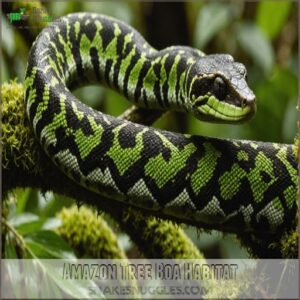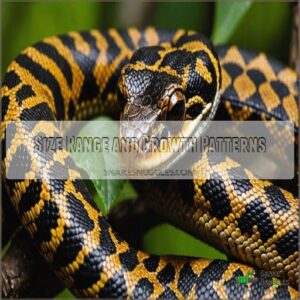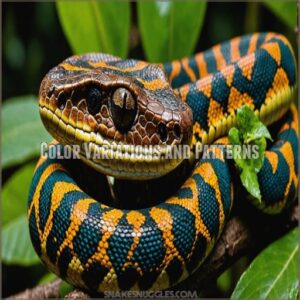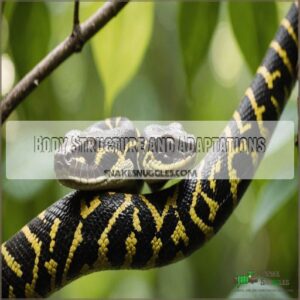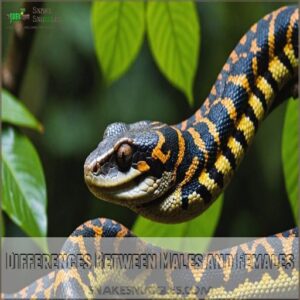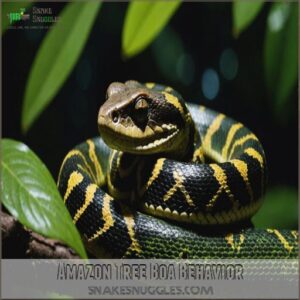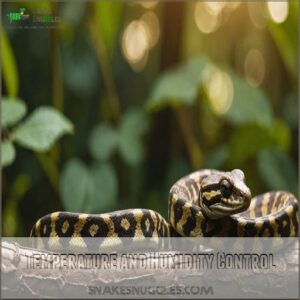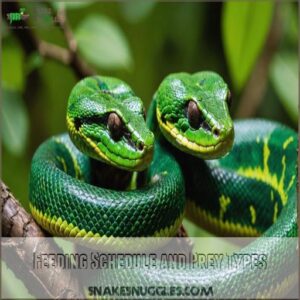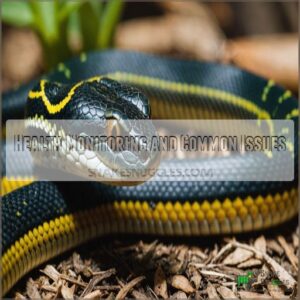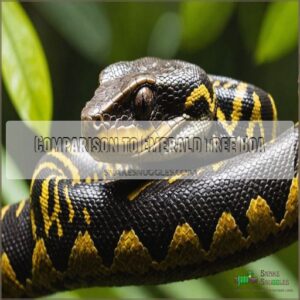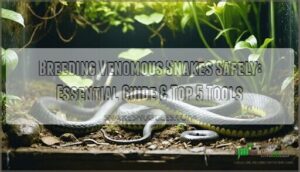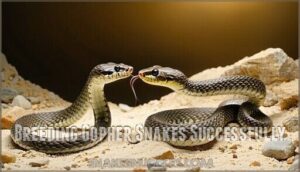This site is supported by our readers. We may earn a commission, at no cost to you, if you purchase through links.
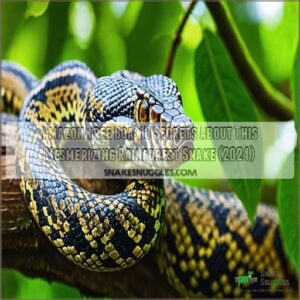 The Amazon tree boa is like the gymnast of the snake world, perfectly at home in the Amazon rainforest’s lofty branches.
The Amazon tree boa is like the gymnast of the snake world, perfectly at home in the Amazon rainforest’s lofty branches.
These non-venomous wonders wrap around tree limbs, using their prehensile tails for support.
They show off with a variety of colors, from earthy browns to fiery reds, and can reach lengths of 6 feet.
These boas prefer the nightlife, hunting small mammals and birds under the cover of darkness.
If you ever meet one, remember it might strike a pose—literally.
Curious about how these snakes differ from their emerald cousins or what makes them thrive in captivity? Keep reading!
Table Of Contents
Key Takeaways
- You’ll see Amazon tree boas master the treetops with ease, using their prehensile tails and impressive climbing skills to navigate the rainforest canopy.
- Don’t be fooled by their vibrant colors; these non-venomous boas are nocturnal hunters, preying on small mammals and birds with stealth and precision.
- Creating a habitat for them means managing temperature and humidity levels to mirror their natural environments; daily misting and heating methods are essential.
- While handling them can be a challenge due to their feisty temperament, respecting their space and needs leads to healthier and happier pets.
Amazon Tree Boa Habitat
You’ll find these elegant tree boas lounging in the lush canopies of South American rainforests, where they’ve mastered the art of wrapping around branches in the most comfortable positions you can imagine.
While they’re most at home in Brazil’s Amazon Basin, you’ll spot these nocturnal acrobats showing off their climbing skills across Venezuela, Guyana, and other tropical regions where humidity levels stay high and temperatures rarely dip below 75°F.
Native Regions in South America
You’ll find Amazon Tree Boas flourishing across the diverse Amazon Basin, from the lush rainforests of Brazil to the remote corners of French Guiana.
These endemic species have carved out their niche in lowland tropical forests, where they thrive alongside local communities.
While most abundant in Brazil’s northern regions, they’ve also been spotted in Venezuela, Colombia, and the Guianas, showcasing the incredible biodiversity of South America’s rainforests.
Preferred Arboreal Lifestyle
Living high in the rainforest canopy, Amazon tree boas showcase remarkable adaptations for their arboreal lifestyle.
These skilled climbers wrap their muscular bodies around branches, using specialized scales for superior grip.
You’ll spot them expertly moving through dense foliage, their slender bodies perfectly suited for reaching prey in tight spaces.
Their prehensile tails act like a fifth limb, providing extra stability during hunting maneuvers.
Climate and Humidity Requirements
Through the steamy canopy of South America’s rainforests, Amazon Tree Boas thrive in environments with 70-85% humidity and temperatures between 75-85°F (24-29°C).
These snakes don’t just tolerate high humidity—they need it for proper shedding and respiratory health.
You’ll want to mist their enclosure daily and maintain a slight temperature drop at night to mimic their natural habitat’s fluctuations.
Typical Forest Canopy Behaviors
Anyone watching an Amazon tree boa in its natural habitat will marvel at its impressive canopy behaviors.
These skilled climbers spend their days coiled around branches, perfectly camouflaged among the leaves.
When night falls, they become active hunters, using their specialized heat-sensing pits to locate prey.
Their unique figure-eight coiling technique helps them stay balanced while moving through the treetops, making predator avoidance a breeze.
Physical Characteristics
You’ll be amazed by the Amazon tree boa’s incredible physical features, from their slender bodies that can stretch up to 6 feet long to their stunning range of colors including red, orange, and yellow patterns.
These remarkable snakes come equipped with large, forward-facing eyes and heat-sensing pits that help them track prey in the dark rainforest canopy.
Size Range and Growth Patterns
Amazon Tree Boas start their journey as tiny 12-inch hatchlings, but don’t let their small size fool you.
These remarkable snakes typically reach lengths of 4-6 feet at maturity, with females growing slightly larger than males, and a great resource to find products for their optimal boa size maturity.
You’ll notice their growth is fastest during the first two years, then gradually slows.
With proper care, they can live 15-20 years in captivity.
Color Variations and Patterns
The mesmerizing color variations of tree boas will leave you in awe.
You’ll find these snakes sporting an incredible range of colors, from earthy browns and grays to vibrant reds and yellows.
Their patterns can include speckling, banding, or solid colors, with unique genetic variations tied to specific geographic regions.
What’s fascinating is how their coloration changes as they age, often starting brighter and mellowing over time.
Body Structure and Adaptations
Built for life in the treetops, these snakes’ bodies are a masterpiece of evolution.
You’ll notice their slim, lightweight frame that’s perfect for wrapping around branches, while their prehensile tail acts like a fifth limb for extra grip.
Heat-sensing pits line their faces, helping them detect warm-blooded prey even in pitch darkness.
Their flexible skeletal structure lets them twist and turn through dense foliage effortlessly.
Differences Between Males and Females
You might notice that male Amazon tree boas are generally smaller than females, which pack on more size due to reproduction needs.
Females are typically more robust, while males tend to be slender.
Coloration varies widely, adding to their mystique, but there’s no clear pattern in gender coloration.
So, whether you’re spotting a male or female, size often tells their story.
Amazon Tree Boa Behavior
When you think about the Amazon Tree Boa, picture a night prowler with an adventurous spirit, always ready to surprise its prey with nimble strikes.
These boas may not win any popularity contests with humans due to their feisty temper, but that just adds to their wild charm, doesn’t it?
Nocturnal Hunting Habits
Their striking scales aren’t just for show; they’re perfect camouflage in the rainforest.
Amazon tree boas are nighttime hunters, patiently waiting in ambush.
Prey selection often depends on size and availability.
Hunting techniques rely heavily on their incredible senses – sight, smell, and heat detection.
Success rate is surprisingly high thanks to their stealth and powerful bite.
These snakes are masters of their nocturnal world.
Interaction With Humans and Handling
After exploring their nighttime antics, let’s talk about handling Amazon tree boas.
Handling these snakes requires patience and finesse—they’re not exactly cuddly.
Their temperament can surprise, so focus on handling techniques and safety precautions.
Remember, these serpents aren’t fans of tight grips.
Keep it light and respectful, aiming for ethical considerations in captivity.
You’ll want to make sure you have the right Amazon tree boa care supplies to keep your snake happy and healthy.
Remember, these serpents aren’t fans of tight grips.
Keep it light and respectful, aiming for ethical considerations in captivity.
Defensive Mechanisms and Striking Behavior
Ever watched an Amazon Tree Boa’s defensive dance?
Their striking behavior is a blend of venom-free standoffs and clever mimicry, often employing threat displays like flattening their heads.
These boas love a good surprise attack, often relying on camouflage to get close.
If that doesn’t work, expect a swift twist of constriction or maybe a tail whip.
Handling these masters of disguise can be quite the adventure!
Social Behavior in The Wild
Just as their defensive antics keep predators at bay, these boas have fascinating social behaviors.
Mating rituals often mimic a dance, with subtle communication methods guiding the rhythm.
Their group dynamics are intriguing, showing territoriality but also cooperation.
While generally solitary, they sometimes share branches, perhaps exchanging notes on predator avoidance strategies.
It’s like a snake’s version of neighborhood watch.
Caring for Amazon Tree Boas
Taking care of an Amazon Tree Boa is like owning a piece of the rainforest, and it starts with setting up a cozy, arboreal-friendly enclosure that mimics their natural habitat.
You’ll need to keep an eye on temperature and humidity, feed them a diet of small mammals, and watch for any health issues, all while enjoying the challenge of sharing your space with such a fascinating creature.
Enclosure Setup and Size Requirements
Setting up the perfect home for your Amazon Tree Boa involves choosing the right enclosure materials and tank size—aim for ten gallons per foot of snake.
Make sure you have excellent ventilation while filling the space with sturdy branches for climbing, like a jungle gym.
Opt for a natural substrate choice to mimic their habitat, keeping your snake comfy and stimulated.
Temperature and Humidity Control
Creating a cozy and comfy habitat for your Amazon Tree Boa means mastering temperature and humidity control.
Heating methods and ventilation systems are key.
Use humidity gauges and misting systems to keep levels right.
Imagine it like a rainforest spa day, maintaining a thermal gradient to help your boa feel right at home—warm at one end, perfect at the other.
Feeding Schedule and Prey Types
Maintaining the right temperature and humidity is only half the battle!
Now, let’s talk food.
Your Amazon tree boa’s feeding frequency depends on its age and size—younger snakes eat more often.
Prey size should match your snake’s girth; think pinky mice or similarly sized rodents.
Nutritional needs are met with varied diets, but always prioritize live prey over frozen for the best digestion.
Remember, improper feeding can lead to digestive issues.
Health Monitoring and Common Issues
Health monitoring for your Amazon Tree Boa means being a snake whisperer.
Keep an eye out for shedding problems, respiratory infections, and dietary deficiencies.
Prevention’s key, so manage parasites and stress effectively, and consider using products for snake parasite treatment to keep your boa healthy.
Stay sharp like a boa’s strike: spot any unusual changes swiftly.
Regular vet checks guarantee your slithery friend stays fit and fabulous in its arboreal kingdom.
Comparison to Emerald Tree Boa
You’re about to discover how the Amazon tree boa stacks up against its glossy green cousin, the emerald tree boa.
These two snakes might share a leafy neighborhood, but their looks and temperaments can be as different as night and day, which might make you wonder who’s the more dazzling rainforest dweller.
Physical Appearance Comparisons
When you’re eyeing an Amazon Tree Boa, its slim body shape and vibrant coloration stand out against the more robust emerald tree boa’s stunning green hue.
Similar to the green tree snake’s color variations, the Amazon Tree Boa’s wild variety of colors is like nature showing off.
Its head shape is narrower, adding to its distinctive look.
Behavioral Differences
Comparing the Amazon Tree Boa and its emerald cousin is like spotting highlights in their behaviors.
The Amazon Tree Boa’s world revolves around:
- Reproduction: Solitary until mating.
- Diet: Feasts on small mammals.
- Predation: Skilled ambusher.
- Socialization: Introverted, keeps to itself.
- Defensive behaviors: Impressive bluff strikes but rarely bites.
Each species tells its own wild tale!
Habitat Preferences
In the dense Amazon, both tree boas select their homes wisely.
The Amazon Tree Boa enjoys the dense canopy, adapting to seasonal variations and vegetation shifts.
The Emerald Tree Boa, however, favors specific tree heights.
Here’s a quick look:
| Species | Tree Selection | Seasonal Variations |
|---|---|---|
| Amazon Tree Boa | Varied | High adaptability |
| Emerald Tree Boa | Specific canopy | Resistant |
Understanding these choices reveals nature’s flexibility.
Care Requirements as Pets
Caring for an Amazon tree boa requires a cozy habitat: think arboreal housing with branches aplenty.
While they share similarities with the emerald tree boa, these boas are more laid-back about vet care, legality issues, and lifespan.
Just don’t shortchange their space or proper temperature.
Embrace their unique needs, and you’ll find breeding success comes naturally with a dash of patience.
Frequently Asked Questions (FAQs)
What do Amazon tree boas eat?
You know those picky eaters at dinner?
Well, Amazon tree boas aren’t like that.
They munch on a wide array of prey, including birds, small mammals, frogs, and lizards—basically anything that fits in their mouths.
How long do Amazon tree boas live?
Amazon tree boas usually live around 15 years in the wild.
They might stretch that lifespan to 20 years when you bring them into a cozy terrarium.
Just don’t forget to keep the heat lamps humming!
Are Amazon tree boas venomous?
Handling a snake can be like handling a rope that moves, but rest easy—Amazon tree boas aren’t venomous.
They rely on constriction to subdue their prey, so there’s no venom to worry about.
How do Amazon tree boas reproduce?
Imagine a snake’s romance in the treetops.
Males use their spurs to grip females during mating, leading to a ballet of scales.
Females lay eggs that hatch after about three to four months.
What are common health issues in Amazon tree boas?
Respiratory infections, parasites, and dysecdysis (shedding problems) are common. Proper husbandry, including consistent humidity and temperature, is key to preventing these issues. Regular vet checkups are also important!
Conclusion
Did you know that over 90% of an Amazon tree boa’s life is spent among the trees?
These arboreal athletes captivate with their color-changing artistry and extraordinary climbing skills.
Whether you’re studying their behavior or considering one as a pet, their adaptability and beauty are unmatched.
These snakes are perfect examples of nature’s creativity, thriving in the wild and enchanting in captivity.
Embrace the Amazon tree boa’s charm, and you’re in for an unforgettable experience.

